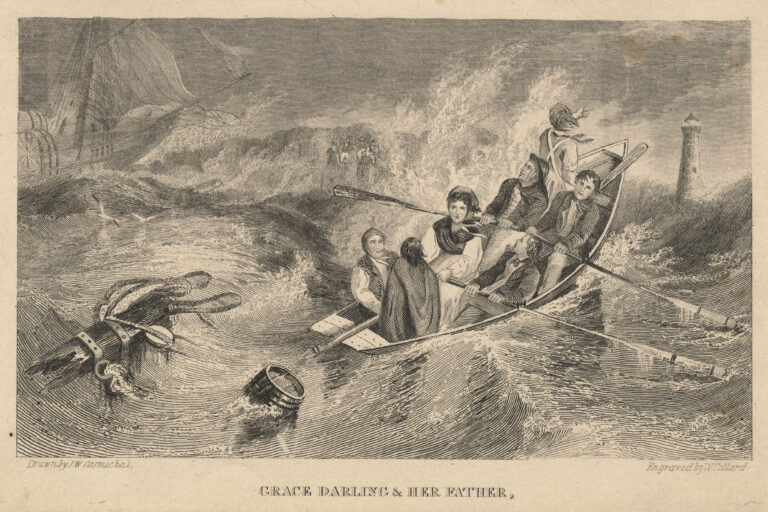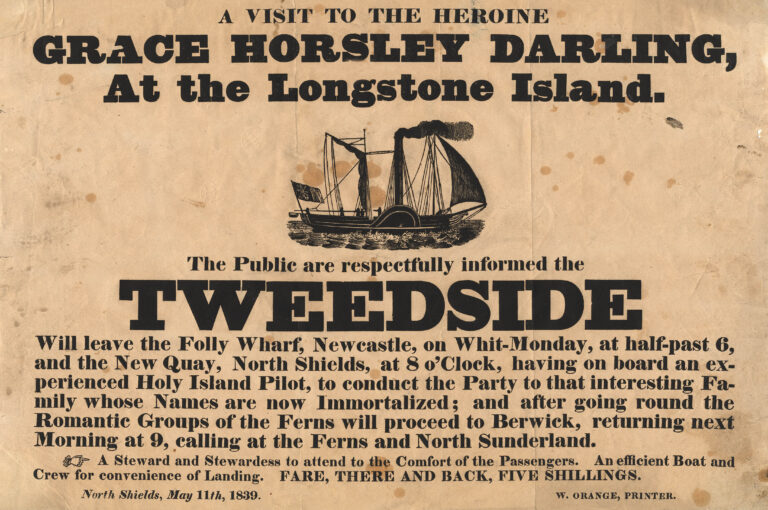Documents Celebrating and Promoting Grace Darling and the Forfarshire Rescue, 1838-39
Reference: SANT/BEQ/14/1/10&11, SANT/BEQ/14/2/15/1
Suggested age groups: KS1, KS2
Subject areas: Shipwrecks, Rescue, Grace Darling, Women’s History, Celebrity Culture
CONTEXT
The Forfarshire rescue took place on 7 September 1838. William Darling was the Keeper of the Longstone Lighthouse on the Farne Islands, off the Northumberland coast. His daughter was Grace Darling.
William and Grace were ‘on alert’ and at quarter to five in the morning on 7th September 1838, Grace spotted a ship wrecked on the rocks. The darkness and poor weather prevented Grace from being able to spot any survivors. By seven o’clock the tide had fallen and William and Grace were able to see three or four men on the rock. The poor weather meant that they did not know if a lifeboat would be able to come from North Sunderland (Seahouses) so they decided to go out to the rocks in their own boat. They found 8 men and 1 woman there. William and Grace made two rescue trips, the first taking four men and the woman to Longstone. Two of the men returned to the rocks with William and brought back the four remaining survivors. Later the North Sunderland lifeboat was able to get to the rock and rescued the bodies of one man and two children. The lifeboat crew were unable to return to the mainland immediately and had to stay on the Farne Islands for two days and nights. The letter is dated 6 October 1838, about a month after the rescue.
This document is a printed supplement to The Recorder, a weekly newspaper. The supplement was published on 23 December 1838 and celebrates Grace Darling’s role in the rescue of the survivors of the wreck of The Forfarshire. The supplement includes an illustration of the rescue and a poem describing the rescue. The supplement focusses on Grace’s role in the rescue. It was very unusual for a woman to be involved in a rescue in the early part of the 19th century. Grace was treated as a celebrity after the rescue. There was no photography at the time of the rescue. Magazines and newspapers therefore employed artists to illustrate rescue scenes and draw portraits of Grace.
This document is a printed image of the Forfarshire rescue ‘Grace Darling & Her Father’. The title is important. Grace Darling is named but her father, William, isn’t. Much of the publicity around the rescue focussed on Grace’s role in it. It was very unusual for a woman to be involved in a rescue in the early part of the 19th century. Grace was treated as a celebrity after the rescue. There was no photography at the time of the rescue. Magazines and newspapers therefore employed artists to illustrate rescue scenes and draw portraits of Grace.
This document is a handbill printed to advertise a sailing trip on a ship called ‘The Tweedside’ to the Farne Islands to visit Grace Darling at the Longstone Lighthouse. The visit was planned for Whit Monday 1839. The handbill tells us that the trip will start from Newcastle, pick up passengers in North Shields, visit the Farne Islands, then go on to Berwick before returning via The Farne Islands and North Sunderland (Seahouses).
A handbill was a printed notices that was circulated to members of the public usually to advertise an event. Have you spotted the old spelling for Farne Islands – Ferns?
The document shows the huge public interest in the Darling family after the rescue of survivors from the Forfarshire.
ACTIVITIES
ACTIVITY 1
Background
The Forfarshire rescue took place on 7 September 1838. William Darling was the Keeper of the Longstone Lighthouse on the Farne Islands, off the Northumberland coast. His daughter was Grace Darling.
SEE
See: Who was William Darling?
See: Who was Grace Darling?
See: How was William Darling related to Grace Darling?
See: What was William Darling’s role at the lighthouse?
See: What happened during the Forfarshire rescue?
See: What was the public reaction to the Forfarshire rescue?
See: Who received the most public attention after the rescue?
See: What is shown in each of these documents?
THINK
Think: What was the public reaction to Grace Darling and the Forfarshire rescue?
Think: How was this different to the public’s reaction to William after the rescue?
Think: Would Grace have become a celebrity if the rescue happened today?
Think: How might William and Grace have felt about the public reaction to the rescue?
Think: What was Grace’s daily life like before the rescue?
Think: How did Grace’s daily life change after the rescue?
Think: How would it feel to become a celebrity overnight?
Think: Why did Grace become a celebrity?
Think: Why was Grace’s father not named in the articles?
DO
Do: Write your own poem about Grace Darling and the Forfarshire rescue.
Do: Visit the Grace Darling Museum.
Do: Create a piece of art depicting the Forfarshire rescue.
Do: Imagine you are Grace Darling, write a diary entry about how you feel about your new celebrity status.
Do: Imagine you are William Darling, write a diary entry about how you feel about Grace’s new celebrity status.
Do: Find evidence of other women involved in sea rescues.
Do: Compare the public response to Grace Darling to that of Margaret Armstrong. Why did one become a celebrity while the other did not?
Resources
OTHER ONLINE RESOURCES
Lifeboats
Northumberland Archives blog on Women and Lifeboats: https://northumberlandarchives.com/test/2021/09/07/women-and-lifeboats/
RNLI home page: https://rnli.org/
History of the RNLI: https://rnli.org/about-us/our-history/timeline
BBC Article on all-female Lifeboat Crews: https://www.bbc.co.uk/news/uk-england-tyne-63991831
Lifeboat Station Project webpage on Women of the RNLI: https://lifeboatstationproject.com/rnli-women/
Grace Darling
RNLI page on the story of Grace Darling: https://rnli.org/magazine/magazine-featured-list/2019/november/the-story-of-grace-darling
Royal Museums Grenwich page on Grace Darling: https://www.rmg.co.uk/stories/topics/grace-darling
RNLI Grace Darling Museum: https://rnli.org/find-my-nearest/museums/grace-darling-museum
BBC Teach Youtube video on Grace Darling: https://www.youtube.com/watch?v=xCL1x7wHQLY&ab_channel=BBCTeach




